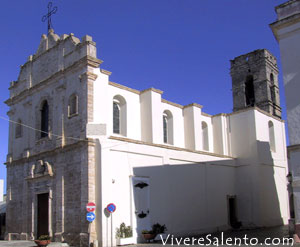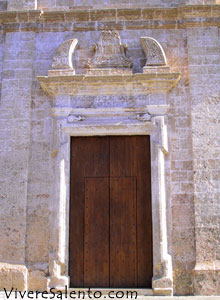|
|

In the historical centre
of Racale you can admire the typical "case a corte" and the wonderful
noble palaces
 such
as the stately Ducal Palace of the Basurtos. It was built in the XVI century,
and it is made up of two enormous towers (dated 1128) that were built by the
Normans to defend the centre from the attacks of their enemies. One of the most
interesting religious monuments is the Mother Church dedicated to St. George. It
was reconstructed in 1756, after the collapse caused by the earthquake in 1743
but it was built for the first time in the XII century. The Church has got a
beautiful façade, decorated with an elegant portal of entry. Inside you can see
some interesting paintings representing holy images, and they might have been
made by Tiso or Catalano. The Church of the Madonna of the River was built in
the XVII century, on an ancient Basilian Crypt. The façade is sober and inside
there are some XVII century paintings. The Church of Our Lady of Sorrows
probably dates back to the XVIII century; on the façade there are three
portals, four statues of saints and a window decorated with two arcs. The
interior is sober and elegant. The Church of St Maria la Nova was built in the
XVI century on a pre-existing building of the XII century. The rests of some
ancient paintings are very interesting to see. Outside the inhabited centre
there are some farms as Ospina Farm where you can also see a megalith.
The Protector of Racale is St Sebastian, who is celebrated on the last Sunday of
May each year such
as the stately Ducal Palace of the Basurtos. It was built in the XVI century,
and it is made up of two enormous towers (dated 1128) that were built by the
Normans to defend the centre from the attacks of their enemies. One of the most
interesting religious monuments is the Mother Church dedicated to St. George. It
was reconstructed in 1756, after the collapse caused by the earthquake in 1743
but it was built for the first time in the XII century. The Church has got a
beautiful façade, decorated with an elegant portal of entry. Inside you can see
some interesting paintings representing holy images, and they might have been
made by Tiso or Catalano. The Church of the Madonna of the River was built in
the XVII century, on an ancient Basilian Crypt. The façade is sober and inside
there are some XVII century paintings. The Church of Our Lady of Sorrows
probably dates back to the XVIII century; on the façade there are three
portals, four statues of saints and a window decorated with two arcs. The
interior is sober and elegant. The Church of St Maria la Nova was built in the
XVI century on a pre-existing building of the XII century. The rests of some
ancient paintings are very interesting to see. Outside the inhabited centre
there are some farms as Ospina Farm where you can also see a megalith.
The Protector of Racale is St Sebastian, who is celebrated on the last Sunday of
May each year

The inhabitants of
Racale are famous for being "pacci", that means crazy. This nickname is closely
connected to a strange ancient story according to which some centuries ago a strange
gentleman arrived in the village and when he walked he used to stop suddenly and
to pray loud. The people of Racale thought he was mad so they did not let him to
stay in their village. The poor man took refuge into a cave, outside the
village. The following day a group of children went near the cave and the man
was very kind to them, so the children started to go often to the cave.
Unfortunately the citizens of Racale did not want their children to play with
that man and they obliged him to go away. Then they discovered that that man
was St. Nicola the Pilgrim. For this reason the inhabitants of the near
villages called the people of Racale mad since they had not been able to
recognise the saint and what is more they had sent him away.
to a strange ancient story according to which some centuries ago a strange
gentleman arrived in the village and when he walked he used to stop suddenly and
to pray loud. The people of Racale thought he was mad so they did not let him to
stay in their village. The poor man took refuge into a cave, outside the
village. The following day a group of children went near the cave and the man
was very kind to them, so the children started to go often to the cave.
Unfortunately the citizens of Racale did not want their children to play with
that man and they obliged him to go away. Then they discovered that that man
was St. Nicola the Pilgrim. For this reason the inhabitants of the near
villages called the people of Racale mad since they had not been able to
recognise the saint and what is more they had sent him away.
|